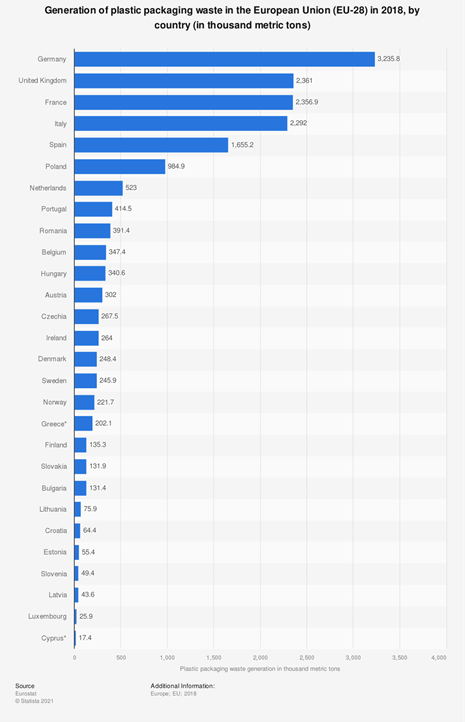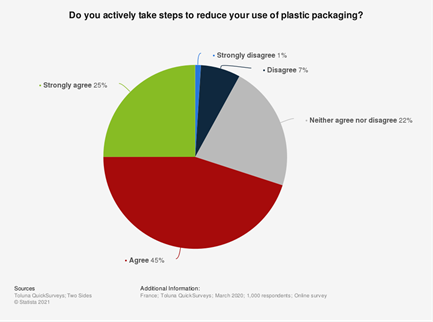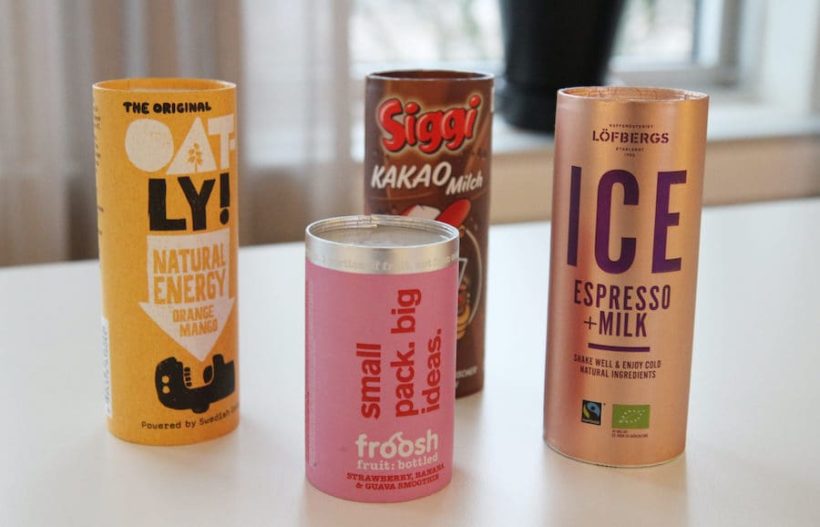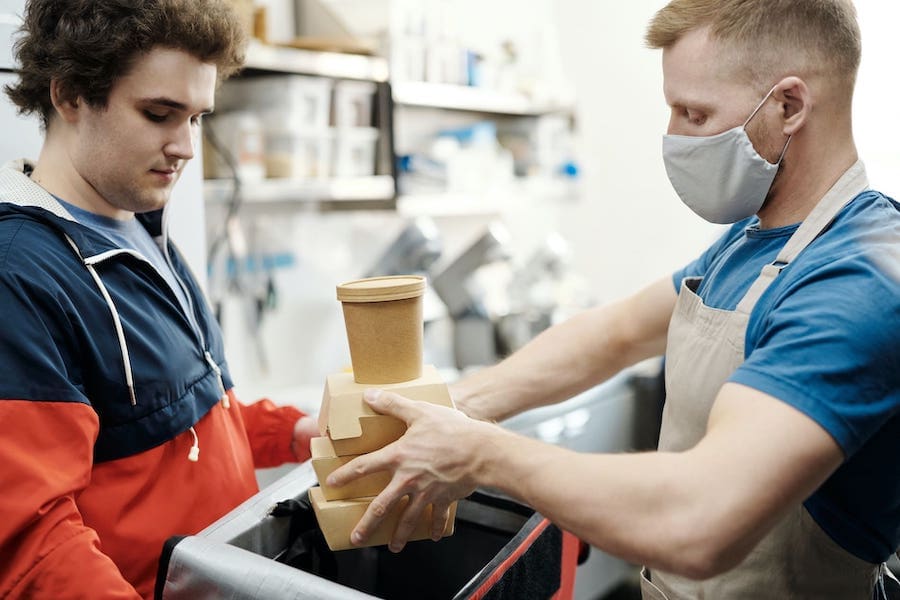As sustainability – in its broadest definition- is an immense challenge to be tackled presently and continuously in the future, consumers want to see it not only in but also around their products: in the packaging of the goods they purchase.
Frequently, plastic is named as a major contributor to environmental issues, and even health concerns.
In 2018, the EU alone created many million metric tons worth of plastic packaging waste. Among the various member states, Germany was the country to generate the largest amount of plastic waste, with around 3.2 million metric tons. Followed by the United Kingdom, France and Italy, the sheer amount of plastic packaging waste generation is immense.
In 2016, the German per capita plastic waste generated was around 38 kg, making it one of the highest in the European Union. Only Luxembourg, Ireland and Estonia had higher per capita values. For comparison: the EU average per capita plastic waste was at 24 kg in 2016.

Graph showing the amount of plastic packaging waste generation in thousand metric tons per country in the EU, 2018
When it comes to packaging, one major sustainability issue is the arising treatment of it once the product is consumed – in other words, what happens to the packaging material once it’s fulfilled its purpose?
Looking at only plastic packaging waste in the European Union, the recycling rate remains rather low, albeit there has been growth between the years of 2010 and 2018 in most member countries.
Among the members with the highest recycling rate in 2018 is Lithuania at 69.3 percent. Germany, while having one of the higher recycling rates for plastic packaging in Europe, has experienced a decline in its rate below the 2010 rate: in 2018, its recycling rate was at 47.1%.
Regarding plastic waste, it often terminates in landfills, rivers and oceans – causing harm to wildlife, water quality, and eventually harming consumers’ health.
That is why a rising number of consumers are paying more attention to how their products are packaged: In France in 2020, consumers were asked whether they were actively taking steps to reduce their plastic consumption, and 70 percent of respondents agreed or strongly agreed.

Survey of French consumers on their behaviour towards plastic packaging, 2020
It is clear now how the sheer amount of packaging waste and the insufficient recycling rates combined create a pressing issue, one that businesses are expected to solve.
Consumers are aware of this issue, and demand for better solutions – specifically, plastic has gained a negative reputation when it comes to sustainability.
However, it is noteworthy that plastic is – contrary to what is often said – not the devil, and it has in fact many useful properties, and may for some cases even be a rather sustainable material choice. For instance, it is lighter and therefore causes less carbon emissions during its transporting stage. Its production is cheaper and less energy-intensive than glass, and it can help conserve food products and others, which in turn reduces waste.
The best way to assess which material may be the better choice is to conduct a life cycle assessment (LCA) of a product, ideally from cradle to cradle, covering all steps of a product.
Still, it is evident that the rate at which we produce and consume plastic is unsustainable, and that major changes are needed if we want to ensure the health of our planet and of us.
But how can companies create truly eco-friendly packaging, while also ensuring competitive prices that are affordable for their customers?
Let’s look at the example of Colgate-Palmolive: In France, the company launched Ploof by Ajax. As opposed to their traditional products, consumers buy one spray bottle which they fill with water at home, and then insert a tablet which creates an Ajax multipurpose cleaner. These tablets are packaged in paper sachets, and the spray bottle is reusable.
This DIY approach with a sustainability focus is gaining in popularity, with numerous companies offering similar products in various areas. Start-ups as well as large corporations adopt such strategies, and market them as waste-reducing ways of consuming. In Germany, there are prominent start-ups such as everdrop and Blaue Helden.

Ploof by Ajax: an example of a DIY approach to cleaning products, by Colgate-Palmolive
In addition to the aforementioned options, many producers look to increase the recyclability of their products, reduce the use of (virgin) plastic in their packaging and adopt circular economy approaches.
Another interesting example is CartoCan® liquid, a completely integrated aseptic packaging system. It is made from renewable resources, and promises the lowest CO2 footprint, as well as being recyclable with a high recovery.

Of course, packaging is only one component of the manifold challenges that sustainability presents. Still, it is a very important point, and one that is impossible to ignore when aiming to live a truly sustainable lifestyle.
Going vegan, protesting for climate change policy measures, … – these are all great ways to take charge of our impact and improve it. However, we need to be mindful of all our behaviours and how they affect the planet. Leaving packaging out of the equation leaves us neglecting a substantial part of our choices that could lead to a more sustainable world.
Of course, there are always trade-offs, but we need to stay consistent in our attitudes and actions.
Therefore – get researching and look into more sustainable options for your packaging!
The aforementioned examples are only the tip of the iceberg, there are many innovative companies out there exploring sustainable packaging options.
But as with anything, packaging sustainability is highly complex – you need to be aware that a product has many different life cycle stages, and some are more impactful than others.
This month’s article deals with the sustainability of packaging – make sure to become a member of the Komoneed community to learn more about how you can improve your lifestyle, and leave a comment down below answering the following questions:
- Did you consider the sustainability impact of packaging before? And do you actively try to improve your footprint in that area?
- What are some issues you have faced in trying to make more sustainable choices?
- Which companies do you know of that are making interesting innovations in their packaging?
- What tips would you give to the Komoneed members for being a more responsible consumer?
Sources
- EU-28: plastic packaging waste generation 2018 | Statista
- Recycling of plastic packaging waste in the EU 2010-2018 | Statista
- Intention to reduce plastic use France 2020 | Statista
- Sustainability Achievements – Performance | Colgate-Palmolive (colgatepalmolive.com)
- Everdrop – Putzmittel Tabs // 1 Tab = 1 Reiniger // ab 1 Euro
- CARTOCAN (cartocansystem.de)
- CartoCan – Stora Enso Oyj (cision.com)
- Blaue Helden | Nachhaltige Reinigungsprodukte
Image





Hi, yes I’ve been aware of the issues with packaging for a while, although I did not fully understand in what ways it impacts the environment. Thanks for the article, it was super interesting! The examples were also nice to see, and I noticed similar products in my local shops too, so I will see what they’re all about.
I think Frosta also had interesting packaging for their frozen products, they even received a sustainability prize for that! Aside from that, I don’t really know that much about good packaging innovations, but I will look into it 🙂
Thanks Emma! You may also visit this Instagram page from Think Indesign
I have cared about my personal footprint for several years now, and that includes the products I buy and their packaging. I try to support zero waste initiatives by companies, but that’s not always possible. Looking forward to more company innovations that allow for more mindful choices!
Thank you Rachel! Not completely possible, but improvable…
I cant believe companies still prioritize profit over the environment. Thoughts?
Profit is essential for businesses to survive, but its time for them to prioritize the long-term health of our planet. Its not a choice between profit or the environment; its about finding a balance for a sustainable future. Lets hold companies accountable for their impact.
Can we just use edible packaging already? Like, who wouldnt want that?! 🌿🍽️
I get the appeal, but practicality and sustainability are key. Edible packaging may not be the best solution for every product or situation. Lets focus on reducing overall packaging waste and using biodegradable materials first. Its a step in the right direction. 🌱🌍
Can we just all agree to bring our own containers already? 🤷♂️ #SustainableChoices
Is it really that hard, or are companies just not trying hard enough?
Maybe we need to rethink our whole approach to packaging. What do you think?
I agree, our current packaging practices are outdated and harmful. Its time to prioritize sustainability over convenience. Lets push for innovative solutions and hold companies accountable for their environmental impact. Its a collective effort that starts with individual choices.